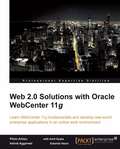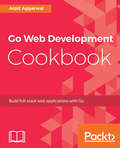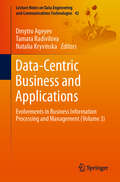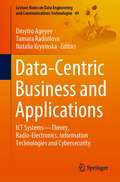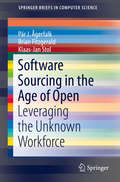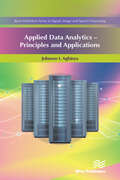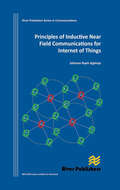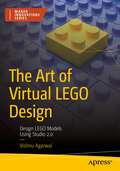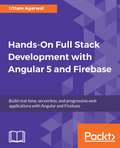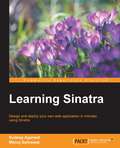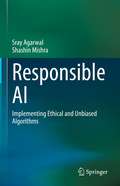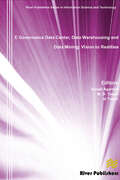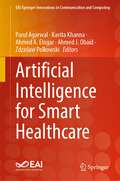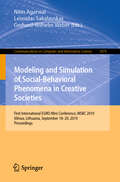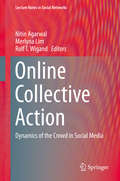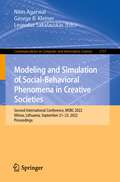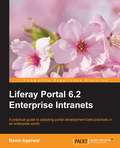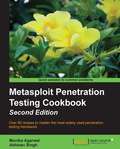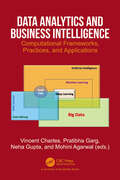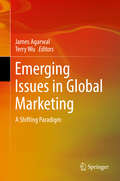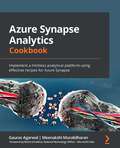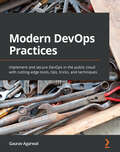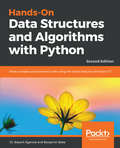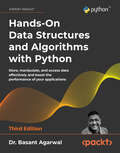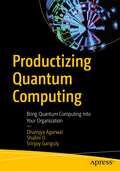- Table View
- List View
Web 2.0 Solutions with Oracle WebCenter 11g
by Ashok Aggarwal Plinio ArbizuThe book starts by explaining the context of the WEB 2.0 platform. It helps the reader to understand its main features and their application in organizations. It shows how the Oracle WebCenter technology can help you implement the Web 2.0 solutions. In each chapter, the theoretical concepts are tested with the help of practical applications. The apt recommendations and suggestions are other key points of the book. Filled with careful step-by-step instructions and plenty of screenshots, this tutorial shows you how to get the most out of the WebCenter Suite 11g. You will learn about integrating various services to enhance your Web 2.0 solutions using Oracle WebCenter. This book is for web developers who need to improve their websites or business applications using Web 2.0 features. This book is recommended for you, if you are a: Portal Developer who works with a traditional portal and wants to move onto new technologies Java Developer and want to add productivity features to your business applications Knowledge Managers and want to create collaborative environments and increase the productivity of your employees and organizational groups
Go Web Development Cookbook: Build full-stack web applications with Go
by Arpit Aggarwal86 recipes on how to build fast, scalable, and powerful web services and applications with GoKey FeaturesBecome proficient in RESTful web servicesBuild scalable, high-performant web applications in GoGet acquainted with Go frameworks for web developmentBook DescriptionGo is an open source programming language that is designed to scale and support concurrency at the language level. This gives you the liberty to write large concurrent web applications with ease. From creating web application to deploying them on Amazon Cloud Services, this book will be your one-stop guide to learn web development in Go. The Go Web Development Cookbook teaches you how to create REST services, write microservices, and deploy Go Docker containers. Whether you are new to programming or a professional developer, this book will help get you up to speed with web development in Go. We will focus on writing modular code in Go; in-depth informative examples build the base, one step at a time. You will learn how to create a server, work with static files, SQL, NoSQL databases, and Beego. You will also learn how to create and secure REST services, and create and deploy Go web application and Go Docker containers on Amazon Cloud Services. By the end of the book, you will be able to apply the skills you've gained in Go to create and explore web applications in any domain.What you will learn Create a simple HTTP and TCP web server and understand how it works Explore record in a MySQL and MongoDB database Write and consume RESTful web service in Go Invent microservices in Go using Micro – a microservice toolkit Create and Deploy the Beego application with Nginx Deploy Go web application and Docker containers on an AWS EC2 instanceWho this book is forThis book is for Go developers interested in learning how to use Go to build powerful web applications. A background in web development is expected.
Data-Centric Business and Applications: Evolvements in Business Information Processing and Management (Volume 3) (Lecture Notes on Data Engineering and Communications Technologies #42)
by Dmytro Ageyev Tamara Radivilova Natalia KryvinskaBuilding on the authors’ previous work, this book addresses key processes and procedures used in information/data processing and management. Modern methods of business information processing, which draw on artificial intelligence, big data, and cloud-based storage and processing, are opening exciting new opportunities for doing business on the basis of information technologies. Thus, in this third book, the authors continue to explore various aspects – technological as well as business and social – of the information industries. Further, they analyze the challenges and opportunities entailed by these kinds of business.
Data-Centric Business and Applications: ICT Systems—Theory, Radio-Electronics, Information Technologies and Cybersecurity (Lecture Notes on Data Engineering and Communications Technologies #69)
by Dmytro Ageyev Tamara Radivilova Natalia KryvinskaThis book, building on the authors’ previous work, presents new communication and networking technologies, challenges and opportunities of information/data processing and transmission. It also discusses the development of more intelligent and efficient communication technologies, which are an essential part of current day-to-day life. Information and Communication Technologies (ICTs) have an enormous impact on businesses and our day-to-day lives over the past three decades and continue to do so. Modern methods of business information processing are opening exciting new opportunities for doing business on the basis of information technologies. The book contains research that spans a wide range of communication and networking technologies, including wireless sensor networks, optical and telecommunication networks, storage area networks, error-free transmission and signal processing.
Software Sourcing in the Age of Open
by Pär J. Ågerfalk Brian Fitzgerald Klaas-Jan StolThis SpringerBrief discusses multiple forms of open-source-inspired outsourcing: opensourcing, innersourcing and crowdsourcing. It uses a framework-based comparison to explain the strengths and weaknesses of each approach. By pointing out characteristics along with benefits and pitfalls of each approach, the authors provide nuanced and research-based advice to managers and developers facing software sourcing decisions. The differences and commonalities of these three emerging approaches are carefully analyzed. Chapters explore the primary challenges of reliability, efficiency and robustness in open-source methods. Examples from industrial cases are included, along with extensive references to recent research. The brief concludes with a comparative analysis of approaches and outlines key implications to be aware of when outsourcing. Software Sourcing in the Age of Open: Leveraging the Unknown Workforce is designed for professionals and researchers interested in outsourcing challenges. The content is also suitable for postgraduate students interested in contemporary software sourcing approaches.
Applied Data Analytics - Principles and Applications
by Johnson I. AgbinyaThe emergence of huge amounts of data which require analysis and in some cases real-time processing has forced exploration into fast algorithms for handling very lage data sizes. Analysis of x-ray images in medical applications, cyber security data, crime data, telecommunications and stock market data, health records and business analytics data are but a few areas of interest. Applications and platforms including R, RapidMiner and Weka provide the basis for analysis, often used by practitioners who pay little to no attention to the underlying mathematics and processes impacting the data. This often leads to an inability to explain results or correct mistakes, or to spot errors.Applied Data Analytics - Principles and Applications seeks to bridge this missing gap by providing some of the most sought after techniques in big data analytics. Establishing strong foundations in these topics provides practical ease when big data analyses are undertaken using the widely available open source and commercially orientated computation platforms, languages and visualisation systems. The book, when combined with such platforms, provides a complete set of tools required to handle big data and can lead to fast implementations and applications.The book contains a mixture of machine learning foundations, deep learning, artificial intelligence, statistics and evolutionary learning mathematics written from the usage point of view with rich explanations on what the concepts mean. The author has thus avoided the complexities often associated with these concepts when found in research papers. The tutorial nature of the book and the applications provided are some of the reasons why the book is suitable for undergraduate, postgraduate and big data analytics enthusiasts.This text should ease the fear of mathematics often associated with practical data analytics and support rapid applications in artificial intelligence, environmental sensor data modelling and analysis, health informatics, business data analytics, data from Internet of Things and deep learning applications.
Principles of Inductive Near Field Communications for Internet of Things
by Johnson I. AgbinyaNear field communication devices and the emerging field of Internet of things require efficient short range communication techniques. Classical telecommunication theory however has so far focused on radiating electromagnetic signals which is more suited to terrestrial communication systems. Over the last decade however considerable research and applications of inductive methods have emerged as innovative approaches for secure short range communications by changing the paradigm of an established model of electromagnetic communications. We have witnessed the emergence of embedded inductive medical devices, magneto-inductive waveguides, inductive pots and cooking devices, magneto-inductive sensors, wireless power transfer, inductive hearing aids and the emerging inductive point-to-point communication specifically termed near-field communication (NFC) as used in mobile phones and payment cards to name a few. While there exist a large set of distributed methods and algorithms detailing the design and performances of such applications, a significant gap is observed as a lack of detailed collection of the methods in one place which could be easily understood and used quickly by someone seeking to apply the methods.In this book this missing gap is filled with the required details and the theory of near field communication systems including both the radiating and reactive (energy coupling) near-field systems in addition to the well known far field radiation techniques. The book details the fundamental expressions and design methods which facilitate the creation of near field devices and equipment including embedded biomedical implants. The book contains recent advances in inductive communications, performance, limitations and a collection of applications. It also lays a strong foundation for the application of inductive methods for creating Internet of Things systems.
The Art of Virtual LEGO Design: Design LEGO Models Using Studio 2.0
by Vishnu AgarwalHave you ever dreamed of designing your own LEGOs? Do you love building huge LEGO models, but don’t have enough bricks? This book will show you how to do all that and more with Bricklink Studio 2.0, a software program that's widely used by LEGO designers to create LEGO models virtually before making them with real LEGO bricks. You'll learn how to start a new project, use the camera control options, and drag and drop parts into your building plate. Then take your bricks from a pile of random pieces into intricate masterpiece models using building tools like Select, Hinge, Clone, Hide, Connect, Collision, and more! You’ll master all the building tools that help you build LEGO models. Then you’ll learn to search and manage LEGO bricks in Studio 2.0 using different palette options like Master, Hidden parts, and Custom parts. Beyond the official LEGO colors, there are special color options you can use to render neon, glow in the dark, and translucent brick. Use this expanded color palette to add to the complexity of your models, and then render your model to see it realistically in 3D! You’ll also learn to animate your model and watch it come to life. After finishing your design, you’ll learn to share what you’ve built with the world. You’ll create professional LEGO instructions for your model that can be printed or shared. Making you a true LEGO design master! What You'll LearnMake fascinating models with virtual LEGO bricks Design LEGO models more efficiently with Studio 2.0’s powerful tools Use “Build Together” simultaneously with another designer on the same project Build massive, amazing models on a small budget Who This Book Is ForAnyone interested in digital modelling or who loves building with LEGOs. Students, hobbyists, and enthusiasts will find fun learning activities.
Hands-On Full Stack Development with Angular 5 and Firebase: Build real-time, serverless, and progressive web applications with Angular and Firebase
by Uttam AgarwalBuild an end-to-end application from development to production by binding Angular with Firebase in this complete guide to web application development Key Features Build a real-time production-ready web application by leveraging the features of Angular as front end and Firebase as the back end Learn more about authentication, databases, and security with Firebase Learn how to grow your application user base using Google analytics and how to make your application PWA compliant. Book Description This book is a complete package for you to build real-time web applications. You will build an end-to-end social networking web application from development to production with Angular as the frontend and Firebase as the backend. You will create an application called Friends with authentication, friends, and chat features. During the process, you’ll use Firebase authentication to register new users and Firebase database to store your extra user data. You’ll take a look at how to store and retrieve your user's images from Firebase storage. Then, you’ll create a real-time chat module with the Firebase database. Next, you’ll secure your database using Firebase security, make your application live with Firebase hosting, and develop your application with analytics. Moving on, you’ll take a look at how to create web pages using bootstrap with HTML, CSS, and TypeScript. You will use the angularfire2 library API in Angular services to interact with Firebase and write unit tests using the Jasmine framework that will help you to write a production-ready application. You’ll also discover various debugging techniques to troubleshoot any bug in your application. Finally, you’ll make your application Progressive Web Applications compliant. By the end of this book, you’ll be able to confidently build any complex application. What you will learn Understand the core concepts of Angular framework Create web pages with Angular as front end and Firebase as back end Develop a real-time social networking application Make your application live with Firebase hosting Engage your user using Firebase cloud messaging Grow your application with Google analytics Learn about Progressive Web App Who this book is for This book is for JavaScript developers who have some previous knowledge of the Angular framework and want to start developing serverless applications with Angular and Firebase. If you are looking for a more practical and less theory-based approach to learn these concepts, then this book is for you.
Learning Sinatra
by Sudeep Agarwal Manoj SehrawatDesign and deploy your own web application in minutes using Sinatra About This Book * Exploit Sinatra to design a web application * Integrate external, internal, and inline CSS and use some popular CSS frameworks * Deploy an application onto your own server or on a cloud application platform Who This Book Is For Learning Sinatra is a great place to start your first Sinatra application. It doesn't matter whether you have written a web application before or not, though some basic knowledge of programming is essential. What You Will Learn * Install and set up Ruby and Sinatra * Work with layouts and template routes * Extend the code to include CSS in different ways * Create projects and understand MVC * Design the front-end with Twitter Bootstrap * Use the MySQL/SQLite gem to communicate with databases * Implement sessions that can be used across multiple pages * Utilize the innovative and user-friendly features of ORMs In Detail Sinatra is a Ruby framework that is widely used in the Industry. You can use it to make a single-page web app or a large-scale one. With the increased online footprint, you can create and deploy your own application. Whether you are brand-new to online learning or a seasoned expert, this book will provide you with the skills you need to successfully create, customize, and deploy a Sinatra application. Starting from the beginning, this book will cover how to install Ruby and Sinatra, construct the back-end, design and customize the front-end layout, and utilize the innovative and user-friendly features of ORMs. By sequentially working through the steps in each chapter, you will quickly master Sinatra's features to create your own application. With ample screenshots and code that offers a play-by-play account of how to build an application, Learning Sinatra will ensure your success with this cutting-edge framework. Style and approach This book takes a step-by-step approach to Sinatra and explains it in a conversational and easy-to-follow style. A simple project is used as a base to explain each topic. The code and screenshots included add to the ease of learning.
Responsible AI: Implementing Ethical and Unbiased Algorithms
by Sray Agarwal Shashin MishraThis book is written for software product teams that use AI to add intelligent models to their products or are planning to use it. As AI adoption grows, it is becoming important that all AI driven products can demonstrate they are not introducing any bias to the AI-based decisions they are making, as well as reducing any pre-existing bias or discrimination. The responsibility to ensure that the AI models are ethical and make responsible decisions does not lie with the data scientists alone. The product owners and the business analysts are as important in ensuring bias-free AI as the data scientists on the team. This book addresses the part that these roles play in building a fair, explainable and accountable model, along with ensuring model and data privacy. Each chapter covers the fundamentals for the topic and then goes deep into the subject matter – providing the details that enable the business analysts and the data scientists to implement these fundamentals. AI research is one of the most active and growing areas of computer science and statistics. This book includes an overview of the many techniques that draw from the research or are created by combining different research outputs. Some of the techniques from relevant and popular libraries are covered, but deliberately not drawn very heavily from as they are already well documented, and new research is likely to replace some of it.
E Governance Data Center, Data Warehousing and Data Mining: Vision to Realities
by Sonali Agarwal M. D. Tiwari Iti TiwariThis book attempts to disseminate information about several E Governance projects and possible Data Mining benefits which are the future of good governance in India.
Artificial Intelligence for Smart Healthcare (EAI/Springer Innovations in Communication and Computing)
by Parul Agarwal Kavita Khanna Ahmed A. Elngar Ahmed J. Obaid Zdzislaw PolkowskiThis book provides information on interdependencies of medicine and telecommunications engineering and how the two must rely on each other to effectively function in this era. The book discusses new techniques for medical service improvisation such as clear-cut views on medical technologies. The authors provide chapters on communication essentiality in healthcare, processing of medical amenities using medical images, the importance of data and information technology in medicine, and machine learning and artificial intelligence in healthcare. Authors include researchers, academics, and professionals in the field.
Modeling and Simulation of Social-Behavioral Phenomena in Creative Societies: First International EURO Mini Conference, MSBC 2019, Vilnius, Lithuania, September 18–20, 2019, Proceedings (Communications in Computer and Information Science #1079)
by Nitin Agarwal Leonidas Sakalauskas Gerhard-Wilhelm WeberThis volume constitutes the proceedings of the First International EURO Mini Conference on Modelling and Simulation of Social-Behavioural Phenomena in Creative Societies, MSBC 2019, held in Vilnius, Lithuania, in September 2019. The 8 full papers and 2 short papers presented were carefully reviewed and selected from 26 submissions. The papers are organized in the following topical sections: computational intelligence in social sciences; modeling and analysis of social-behavioral processes.
Online Collective Action
by Nitin Agarwal Merlyna Lim Rolf T. WigandThis work addresses the gap in the current collective action literature exposed by the new Information and Communication Technologies (ICTs) landscape by bringing together qualitative and quantitative studies from computational and social sciences. The book offers a rigorous and systematic investigation of both methodological and theoretical underpinnings and, thus, collectively promotes a symbiotic and synergistic advancement of the multiple interconnected disciplines in studying online collective actions. More specifically, the book is intended to illuminate several fundamental and powerful yet theoretically undeveloped and largely unexplored aspects of collective action in the participatory media (e. g. , social media). Through in-depth exploration of relevant concepts, theories, methodologies, applications, and case studies, the reader will gain an advanced understanding of collective action with the advent of the new generation of ICTs enabled by social media and the Internet. The developed theories will be valuable and comprehensive references for those interested in examining the role of ICTs not only in collective action but also in decision and policy making, understanding the dynamics of interaction, collaboration, cooperation, communication, as well as information flow and propagation, and social network research for years to come. Further, the book also serves as an extensive repository of data sets and tools that can be used by researchers leading to a deeper and more fundamental understanding of the dynamics of the crowd in online collective actions.
Modeling and Simulation of Social-Behavioral Phenomena in Creative Societies: Second International Conference, MSBC 2022, Vilnius, Lithuania, September 21–23, 2022, Proceedings (Communications in Computer and Information Science #1717)
by Nitin Agarwal George B. Kleiner Leonidas SakalauskasThis book constitutes the joint refereed proceedings of the Second International Conference on Modeling and Simulation of Social-Behavioral Phenomena in Creative Societies, MSBC 2022, held in Vilnius, Lithuania, in September 2022.The 14 full papers and 1 short paper presented were carefully reviewed and selected from 35 submissions. The papers are organized in the following topical sections: simulation of behavioral processes; modeling of sustainability; and data science and modeling.
Liferay 6.2 Intranet Portal Development Guide
by Navin AgarwalThis book is for anyone who is interested in the Liferay Intranet Portal. This book is for both beginners and more experienced portal developers who need to create an enterprise intranet portal for their business. It will be handy for IT professionals who know the basics of how the portal technology works and need to integrate different open source technologies.
Metasploit Penetration Testing Cookbook, Second Edition
by Monika Agarwal Abhinav SinghThis book follows a Cookbook style with recipes explaining the steps for penetration testing with WLAN, VOIP, and even cloud computing. There is plenty of code and commands used to make your learning curve easy and quick.This book targets both professional penetration testers as well as new users of Metasploit, who wish to gain expertise over the framework and learn an additional skill of penetration testing, not limited to a particular OS. The book requires basic knowledge of scanning, exploitation, and the Ruby language.
Data Analytics and Business Intelligence: Computational Frameworks, Practices, and Applications
by Mohini AgarwalBusiness Analytics (BA) is an evolving phenomenon that showcases the increasing importance of using huge volumes of data to generate value for businesses. Advances in BA have offered great opportunities for organisations to improve, innovate, and develop existing or new processes, products, and services. BA is the process of transforming data into actionable insight by using statistical and mathematical analysis, descriptive, prescriptive, and predictive models, machine learning, information systems and network science methods, among others, along with a variety of data, expert knowledge, and fact-based management to support better and faster decision-making. BA and Business Intelligence (BI) generate capabilities for companies to compete in the market effectively and has become one of the main functional areas in most companies. BA tools are used in diverse ways, for example, to identify consumer behaviour patterns and market trends, to derive valuable insights on the performance of stocks, to find information on the attrition rate of employees, to analyse and solve healthcare problems, to offer insight into inventory management and supply chain management, to analyse data from social networks, and to infer traffic behaviour and develop traffic management policy, among others. BA and BI have become one of the most popular research areas in academic circles, as well as in the industry, driven by the increasing demand in the business world. This book aims to become a stimulus for innovative business solutions covering a wide range of aspects of business analytics, such as management science, information technology, descriptive, prescriptive, and predictive models, machine learning, network science, mathematical and statistical techniques. The book will encompass a valuable collection of chapters exploring and discussing computational frameworks, practices, and applications of BA that can assist industries and relevant stakeholders in decision-making and problem-solving exercises, with a view to driving competitive advantage.
Emerging Issues in Global Marketing: A Shifting Paradigm
by James Agarwal Terry WuThis book examines emerging theories, frameworks, and applications of global marketing for the 21st century. It highlights how global marketing is changing in a globalized and digital economy that is fast increasing in complexity and uncertainty. The traditional approach to global marketing is no longer sufficient to address the emerging issues in global markets. Global companies need to challenge traditional assumptions in global marketing in an era of shifting political, cultural, economic, and technological changes. They need to take a fresh look at the contemporary threats and opportunities in markets, institutions, and technology and how they affect entry and expansion strategies through careful re-calibration of the marketing-mix. This book offers new insights for global marketing that addresses these issues. This book should be an ideal resource to both academic scholars and reflective practitioners globally such as CEOs and chief marketing officers as well as government officials and policy makers interested in formulating strategies/policies for global marketing activities in the face of a globalized and digitized economy. This well-crafted research volume is an excellent addition to the growing literature on new trends in international marketing. The authors present the latest insight on the impact of phenomena such as cross-border e-commerce and digital markets, and they discuss new tools for political risk assessment, international branding and more broadly the reconfiguring of marketing-mix strategies – A powerful reminder that the new global market remains a rugged landscape. - Alain Verbeke, McCaig Research Chair in Management and Editor-in-Chief Journal of International Business Studies, University of Calgary, Canada. Emerging trends in institutions, markets, and societies, along with new technological advances, are redefining the scope and strategy in global marketing. Professors Agarwal and Wu have assembled a remarkable collection of cutting-edge topics and issues that capture the shifting paradigm and contemporary developments in the global marketing field. This is an informative and timely resource that makes a valuable contribution, useful for both scholars and business practitioners of global marketing. - Constantine S. Katsikeas, Arnold Ziff Endowed Research Chair in Marketing & International Management, Editor-in-Chief Journal of International Marketing, University of Leeds, UK. This book presents new and cutting-edge thinking at a time when the traditional views of international marketing need to be scrapped. Convergence forces are creating new opportunities as well as threats on a daily basis, and marketing practitioners as well as scholars must be forewarned as well as forearmed on how to deal with these changes. The real growth is coming from the emerging nations, and the theories that provided sufficient insights ten years ago have been completely outmoded by the ever-accelerating rate of innovation and technological change as well as the pressures to address the needs of all of the firm’s relevant stakeholders. The strategic insights provided here are absolutely invaluable. Don’t miss an opportunity to read this book!! - John B. Ford, Professor of Marketing & International Business, Eminent Scholar & Haislip-Rohrer Fellow, Editor-in-Chief, Journal of Advertising Research, Old Dominion University, USA.
Azure Synapse Analytics Cookbook: Implement a limitless analytical platform using effective recipes for Azure Synapse
by Gaurav Agarwal Meenakshi Muralidharan Rohini SrivathsaWhether you're an Azure veteran or just getting started, get the most out of your data with effective recipes for Azure SynapseKey FeaturesDiscover new techniques for using Azure Synapse, regardless of your level of expertiseIntegrate Azure Synapse with other data sources to create a unified experience for your analytical needs using Microsoft AzureLearn how to embed data governance and classification with Synapse Analytics by integrating Azure PurviewBook DescriptionAs data warehouse management becomes increasingly integral to successful organizations, choosing and running the right solution is more important than ever. Microsoft Azure Synapse is an enterprise-grade, cloud-based data warehousing platform, and this book holds the key to using Synapse to its full potential. If you want the skills and confidence to create a robust enterprise analytical platform, this cookbook is a great place to start. You'll learn and execute enterprise-level deployments on medium-to-large data platforms. Using the step-by-step recipes and accompanying theory covered in this book, you'll understand how to integrate various services with Synapse to make it a robust solution for all your data needs. Whether you're new to Azure Synapse or just getting started, you'll find the instructions you need to solve any problem you may face, including using Azure services for data visualization as well as for artificial intelligence (AI) and machine learning (ML) solutions. By the end of this Azure book, you'll have the skills you need to implement an enterprise-grade analytical platform, enabling your organization to explore and manage heterogeneous data workloads and employ various data integration services to solve real-time industry problems.What you will learnDiscover the optimal approach for loading and managing dataWork with notebooks for various tasks, including MLRun real-time analytics using Azure Synapse Link for Cosmos DBPerform exploratory data analytics using Apache SparkRead and write DataFrames into Parquet files using PySparkCreate reports on various metrics for monitoring key KPIsCombine Power BI and Serverless for distributed analysisEnhance your Synapse analysis with data visualizationsWho this book is forThis book is for data architects, data engineers, and developers who want to learn and understand the main concepts of Azure Synapse analytics and implement them in real-world scenarios.
Modern DevOps Practices: Implement and secure DevOps in the public cloud with cutting-edge tools, tips, tricks, and techniques
by Gaurav AgarwalEnhance DevOps workflows by integrating the functionalities of Docker, Kubernetes, Spinnaker, Ansible, Terraform, Flux CD, CaaS, and more with the help of practical examples and expert tipsKey FeaturesGet up and running with containerization-as-a-service and infrastructure automation in the public cloudLearn container security techniques and secret management with Cloud KMS, Anchore Grype, and Grafeas KritisLeverage the combination of DevOps, GitOps, and automation to continuously ship a package of softwareBook DescriptionContainers have entirely changed how developers and end-users see applications as a whole. With this book, you'll learn all about containers, their architecture and benefits, and how to implement them within your development lifecycle.You'll discover how you can transition from the traditional world of virtual machines and adopt modern ways of using DevOps to ship a package of software continuously. Starting with a quick refresher on the core concepts of containers, you'll move on to study the architectural concepts to implement modern ways of application development. You'll cover topics around Docker, Kubernetes, Ansible, Terraform, Packer, and other similar tools that will help you to build a base. As you advance, the book covers the core elements of cloud integration (AWS ECS, GKE, and other CaaS services), continuous integration, and continuous delivery (GitHub actions, Jenkins, and Spinnaker) to help you understand the essence of container management and delivery. The later sections of the book will take you through container pipeline security and GitOps (Flux CD and Terraform).By the end of this DevOps book, you'll have learned best practices for automating your development lifecycle and making the most of containers, infrastructure automation, and CaaS, and be ready to develop applications using modern tools and techniques.What you will learnBecome well-versed with AWS ECS, Google Cloud Run, and KnativeDiscover how to build and manage secure Docker images efficientlyUnderstand continuous integration with Jenkins on Kubernetes and GitHub actionsGet to grips with using Spinnaker for continuous deployment/deliveryManage immutable infrastructure on the cloud with Packer, Terraform, and AnsibleExplore the world of GitOps with GitHub actions, Terraform, and Flux CDWho this book is forIf you are a software engineer, system administrator, or operations engineer looking to step into the world of DevOps within public cloud platforms, this book is for you. Existing DevOps engineers will also find this book useful as it covers best practices, tips, and tricks to implement DevOps with a cloud-native mindset. Although no containerization experience is necessary, a basic understanding of the software development life cycle and delivery will help you get the most out of the book.
Hands-On Data Structures and Algorithms with Python: Write complex and powerful code using the latest features of Python 3.7, 2nd Edition
by Dr Basant AgarwalLearn to implement complex data structures and algorithms using PythonKey FeaturesUnderstand the analysis and design of fundamental Python data structuresExplore advanced Python concepts such as Big O notation and dynamic programmingLearn functional and reactive implementations of traditional data structuresBook DescriptionData structures allow you to store and organize data efficiently. They are critical to any problem, provide a complete solution, and act like reusable code. Hands-On Data Structures and Algorithms with Python teaches you the essential Python data structures and the most common algorithms for building easy and maintainable applications.This book helps you to understand the power of linked lists, double linked lists, and circular linked lists. You will learn to create complex data structures, such as graphs, stacks, and queues. As you make your way through the chapters, you will explore the application of binary searches and binary search trees, along with learning common techniques and structures used in tasks such as preprocessing, modeling, and transforming data. In the concluding chapters, you will get to grips with organizing your code in a manageable, consistent, and extendable way. You will also study how to bubble sort, selection sort, insertion sort, and merge sort algorithms in detail.By the end of the book, you will have learned how to build components that are easy to understand, debug, and use in different applications. You will get insights into Python implementation of all the important and relevant algorithms.What you will learnUnderstand object representation, attribute binding, and data encapsulationGain a solid understanding of Python data structures using algorithmsStudy algorithms using examples with pictorial representationLearn complex algorithms through easy explanation, implementing PythonBuild sophisticated and efficient data applications in PythonUnderstand common programming algorithms used in Python data scienceWrite efficient and robust code in Python 3.7Who this book is forThis book is for developers who want to learn data structures and algorithms in Python to write complex and flexible programs. Basic Python programming knowledge is expected.
Hands-On Data Structures and Algorithms with Python: Store, manipulate, and access data effectively and boost the performance of your applications, 3rd Edition
by Dr. Basant AgarwalUnderstand how implementing different data structures and algorithms intelligently can make your Python code and applications more maintainable and efficientKey FeaturesExplore functional and reactive implementations of traditional and advanced data structuresApply a diverse range of algorithms in your Python codeImplement the skills you have learned to maximize the performance of your applicationsBook DescriptionChoosing the right data structure is pivotal to optimizing the performance and scalability of applications. This new edition of Hands-On Data Structures and Algorithms with Python will expand your understanding of key structures, including stacks, queues, and lists, and also show you how to apply priority queues and heaps in applications. You'll learn how to analyze and compare Python algorithms, and understand which algorithms should be used for a problem based on running time and computational complexity. You will also become confident organizing your code in a manageable, consistent, and scalable way, which will boost your productivity as a Python developer. By the end of this Python book, you'll be able to manipulate the most important data structures and algorithms to more efficiently store, organize, and access data in your applications.What you will learnUnderstand common data structures and algorithms using examples, diagrams, and exercisesExplore how more complex structures, such as priority queues and heaps, can benefit your codeImplement searching, sorting, and selection algorithms on number and string sequencesBecome confident with key string-matching algorithmsUnderstand algorithmic paradigms and apply dynamic programming techniquesUse asymptotic notation to analyze algorithm performance with regard to time and space complexitiesWrite powerful, robust code using the latest features of PythonWho this book is forThis book is for developers and programmers who are interested in learning about data structures and algorithms in Python to write complex, flexible programs. Basic Python programming knowledge is expected.
Productizing Quantum Computing: Bring Quantum Computing Into Your Organization
by Dhairyya Agarwal Shalini D Srinjoy GangulyLeverage the benefits of quantum computing by identifying business use cases and understanding how to design and develop quantum products and services. This book will guide you to effectively productize quantum computing, including best practices, recommendations, and proven methods to help you navigate the challenges and risks of this emerging technology. The book starts with a thorough introduction to quantum computing, followed by its various algorithms and applications. You will then learn how to build a strong foundation in classical computing, seek practical experience, and stay up-to-date with the latest developments in the field. Moving forward, you will gain an understanding of how to conduct market research to identify business opportunities for quantum computing products and services. The authors then guide you through the process of developing a quantum roadmap and integrating quantum computing into an existing system. This is concluded by a demonstration of how to manage quantum computing projects and how to address their risks and challenges. After reading this book, you will understand quantum computing and how it can be applied to real-world business problems. What You Will Learn Identify business use cases for quantum computing and understand the potential benefits and risks of quantum applicationsDesign and develop quantum products and services by identifying quantum algorithms, programming in quantum languages, and leveraging quantum simulators and hardwareIntegrate quantum computing into existing systemsIntegrate quantum algorithms with classical algorithms Who This Book Is For Product managers, developers, and entrepreneurs who wish to use the potential of quantum computing for their businesses.
